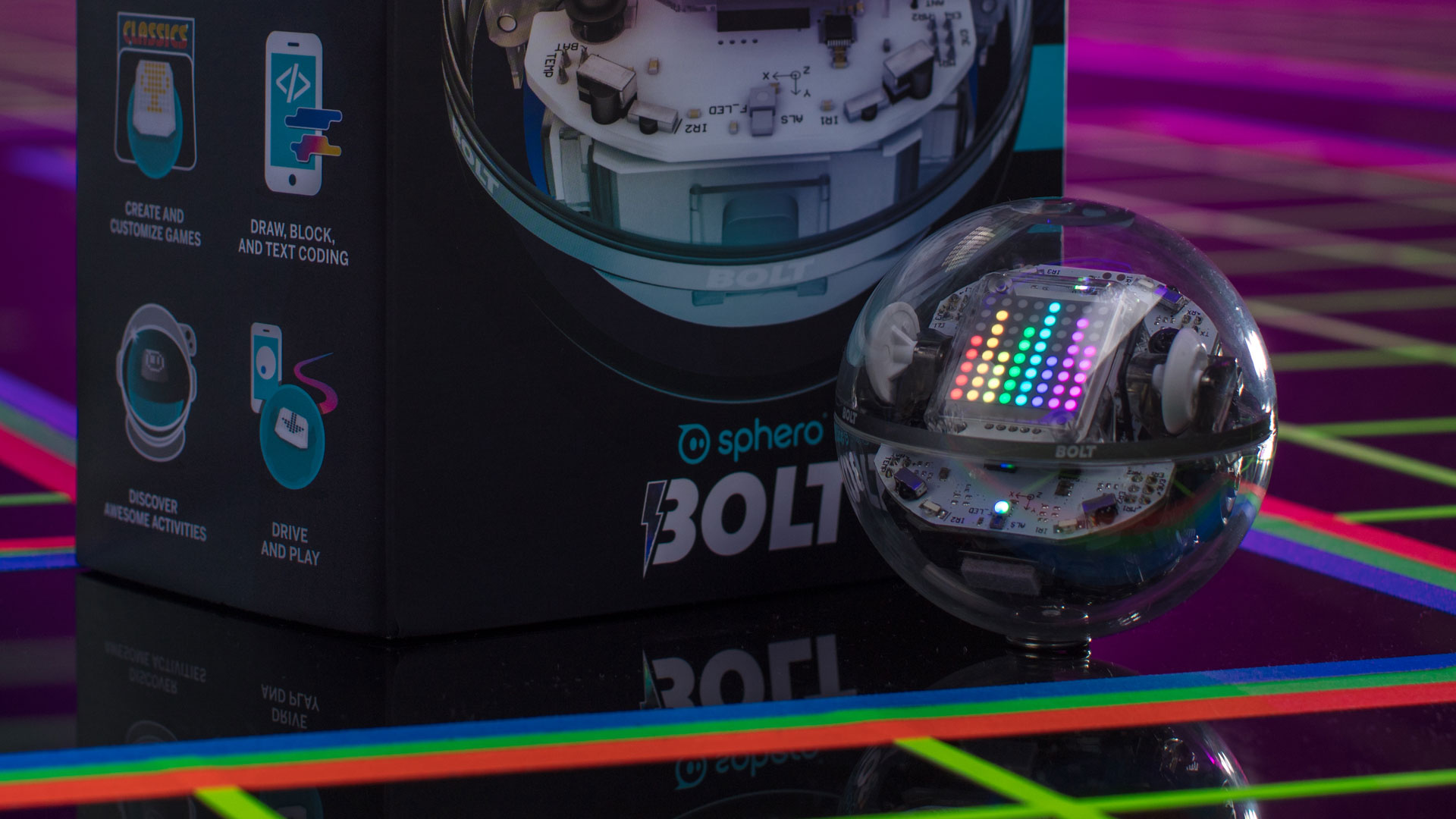Life after BB-8: Sphero Bolt and electrifying the classroom
Hitting the Mothercode in connected learning

When Star Wars: The Force Awakens hit cinemas, it was difficult to avoid the… ahem, force of the marketing blitz surrounding the film. The franchise had been a goldmine for merchandising for decades, but atop the mountain of throwaway plastic accompanying its release, one toy stood tall – the Sphero BB-8.
The result of a Disney accelerator program that the company had joined in 2014, it put Sphero on the map in a way that its previous products, the eponymous Sphero, the Ollie and Sphero Mini, had not.
It was followed by an impressive Sphero R2-D2 droid, perfectly recreating the iconic character’s movements and sounds, a chatty voice-activated Sphero Spider-Man, and an RC car with robotic features based on Pixar’s Cars’ Lightning McQueen.
But, it now looks like Sphero is turning its back on licensed products, in favour of the classroom. Whether it is due to sales, licensing costs or the natural expiration of the agreement with Disney, Sphero is looking to the education space with a laser focus going forward – and it’s doing so with a new, perfectly suited product, the Sphero Bolt, priced at £149.99 in the UK, $149.99 in the US, and AU$249.99 when it lands this month.

While the ball-shaped robot features recreational play modes, the Sphero Bolt is all about coding and programming.
For the purpose, the transparent sphere is loaded with essentially every sensor you can think of, from light sensors to IR sensors, gyroscopes to magnetometers and accelerometers, as well as the motors needed to get it hurtling around the floor and an 8x8 programmable dot matrix display that can be programmed to display any pixelated message or icon the user can imagine within those confines.
Ode to the code
The Sphero Bolt connects to a pair of linked apps (one focussed on play, the other on teaching the principles of coding), with each putting the aforementioned sensors to work.
Get daily insight, inspiration and deals in your inbox
Sign up for breaking news, reviews, opinion, top tech deals, and more.
It harks back to Sphero’s earliest days.
“The company was founded back in 2010,” Sphero CEO Paul Berberian told TechRadar.
“We were hackers and makers and roboticists – it was all around the idea of asking the question ‘how can the smartphone connect to the physical world?’ In 2010 there wasn't a lot out there.
"The iPad was just barely released and the only thing that you could possibly find that could connect to your smart device was a Bluetooth speaker.
“So we were some of the very first products on the market that used Bluetooth to talk to our devices. And we really wanted to make hardware that was fun to play with, easily hackable, programmable.
"We actually had our first hack event before we had our first product. So being able to program our robots was really the foundation to everything we did.”

The educational side of the app package then is designed to make programming as inviting as possible. It’s based on the Scratch programming language, a very visual method that uses colorful blocks of command chains to illustrate the actions the Sphero Bolt will carry out when triggered.
Once these have been laid down, you can then show the Scratch language side-by-side with its Javascript counterpart to see how it translates into a widely-used text-based programming language. This way, you can then learn bits about the more complicated coding language too.
“We went to Scratch based programming because it’s a language that multiple organizations around the world are using,” said Nick Delyani, senior director of marketing for Sphero.
“At Sphero we don't want to come up with a proprietary language that you learn, and then you go to try to use it in the outside world and you’re not able to. That’s a thing we’re really cognisant about when we’re developing our products and our language.”
As an example then, you could Scratch program the Sphero Bolt to roll 100 centimetres underneath a sofa, have its light sensor note the drop in brightness, flash a lightbulb icon that you’ve programmed into the color-changing dot matrix screen, and then reverse at high speed back into the light. Or it could be programmed to run an assault course with millimeter-perfect accuracy, with each action then relayed on your device’s screen in Javascript.
The Sphero Bolt is also massively durable. Not only is it fully waterproofed, but during our demo CEO Paul Berberian threw it forcefully towards the floor without a care for damaging the delicate components housed in its tough outer shell.
The classroom can be akin to a warzone, with clumsy kids happily destroying all they come into contact with, and Sphero is hoping the Bolt’s toughness will make it stand out against competition like the less-ruggedised Anki Cosmo.
The classroom of the future
In addition, Sphero is selling the Bolt in multipacks direct to schools, in boxes of 15 units. These “Power Packs” are battle-ready too – the hard case is designed to be easily transportable, whether on the road or between classrooms.
It has the capacity to charge all 15 Sphero Bolt robots at once over the course of 6 hours, ready for the next day’s lessons. The sensors onboard even let the bots work and communicate in swarms – perfect for use in a team-building scenario.

It’s these sorts of considerations that have made Sphero’s previous products so well suited to the classroom. Sphero devices are in use in 20,000 schools around the globe, in the hands of 1.3 million students.
It’s even inspired the Sphero Heroes ambassador program, where educational professionals from around the world and across disciplines share within a Sphero-supported community their classroom findings.
The fact these ambassadors do so unpaid and without direct sponsorship speaks volumes of just how enamoured the teaching community has become with Sphero.
Sphero Bolt represents the next chapter then in the company’s story, but the charm of the licensed Disney products won’t be abandoned.
“The lessons we learned from making licensed products, you’ll see some of those lessons come to life in next year’s products,” says Berberian.
"It takes a few years – this product was in development while we were shipping Lightning McQueen and Spider-Man, so this product has been in development for a year.
"We’re taking the lessons we learned from animators and storytellers to expand our product offering so that we can reach younger kids and potentially scale up in what we do.
“You’ll always see this notion of play versus learning. But they combine together [...] some kids may be more musically oriented, some more drawn by art.
“How do we reach kids where they’re at, but make them literate in technology, bring coding in but not make it scary, make it just as natural as speaking your mother tongue? It’s very important, because the jobs of the future are not the jobs of today.”
- Best toys 2018: smart toys for kids of all ages
Gerald is Editor-in-Chief of iMore.com. Previously he was the Executive Editor for TechRadar, taking care of the site's home cinema, gaming, smart home, entertainment and audio output. He loves gaming, but don't expect him to play with you unless your console is hooked up to a 4K HDR screen and a 7.1 surround system. Before TechRadar, Gerald was Editor of Gizmodo UK. He is also the author of 'Get Technology: Upgrade Your Future', published by Aurum Press.
